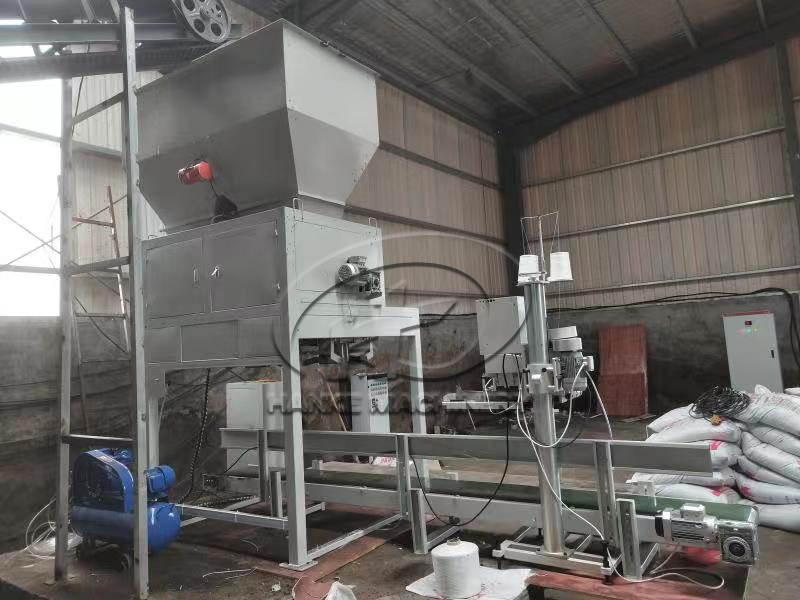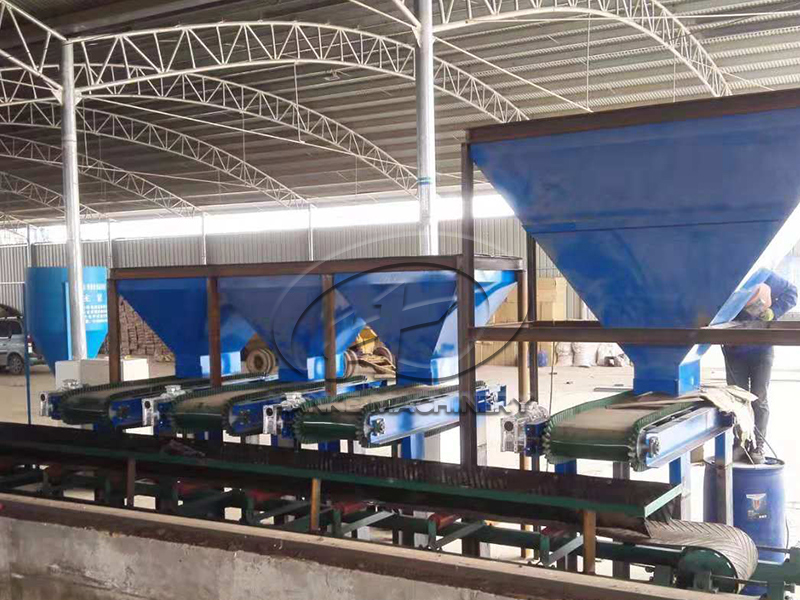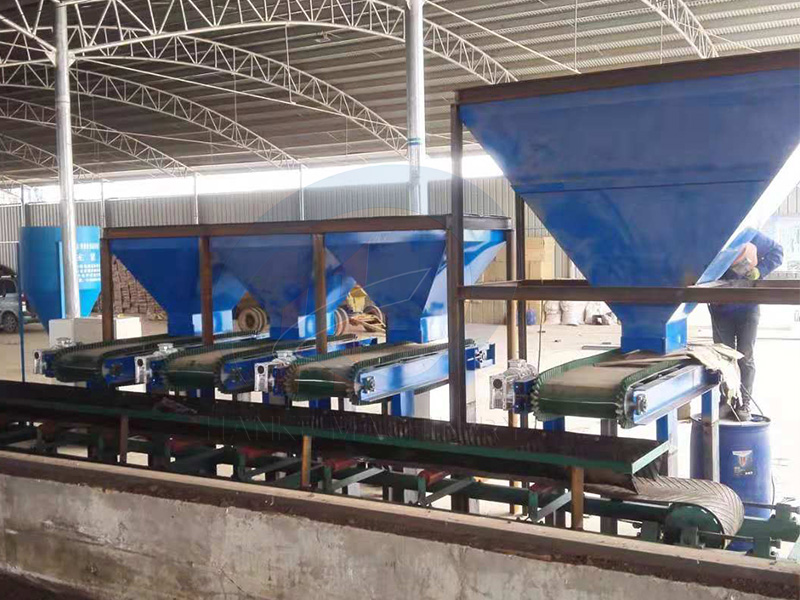 HOME > News > Industry News > Introduction to Key Maintenance Points for the Core Components of BB Fertilizer Weighing, Blending a
HOME > News > Industry News > Introduction to Key Maintenance Points for the Core Components of BB Fertilizer Weighing, Blending a Update time : 2025-09-05 Publisher:Zhengzhou Hanke Machinery
The BB fertilizer (blended fertilizer) weighing and blending packaging machine is a specialized equipment designed for accurately weighing and evenly blending multiple granular or powdered raw materials in preset proportions and then packaging them in fixed quantities. Its core functions revolve around "precise weighing", "even blending", and "stable packaging", and it is widely used in fertilizer manufacturing enterprises. The maintenance and upkeep, common faults, and selection criteria of this machine directly affect production efficiency and product quality. The following provides a detailed explanation from four aspects: core structure, maintenance and upkeep, common faults, and selection suggestions.
I. Core Structure of BB Fertilizer Weighing and Blending Fertilizer Packaging Machine
Understanding the structure is the foundation for good maintenance. The equipment mainly consists of four parts: raw material storage system, weighing and metering system, blending and stirring system, and packaging and sealing system. These parts work together to achieve the entire process of "raw material storage - weighing - blending - packaging".
Raw material storage system: Multiple silos (corresponding to different raw materials such as nitrogen, phosphorus, potassium and trace elements), equipped with vibrating or screw feeding devices to control the rate of raw material descent.
2. Weighing and metering system: The core is "load cell + weighing hopper", and some equipment includes "coarse feeding + fine feeding" dual modes (coarse feeding for rapid discharge, fine feeding for topping up to the precise weight, reducing errors).
3. Mixing and stirring system: Mostly adopts double-screw stirring or paddle stirring to ensure uniform mixing of different raw materials (avoid stratification and guarantee consistency of BB fertilizer nutrients).
4. Packaging sealing system: It includes modules such as bag conveying, filling, sewing (or heat sealing), and shaping, and is suitable for common packaging forms such as woven bags and composite bags.
II. Maintenance and Care of Core Components (Weighing / Mixing / Packaging)
The maintenance core of BB fertilizer packaging machine is "preventing clogging, wear and tear, and precision drift". It should be carried out in accordance with "daily inspection + regular in-depth maintenance", as detailed below:
1. Weighing and measurement system: Preventing accuracy deviation (the most crucial)
The weighing system is the core for ensuring the "accurate nutrient ratio" of BB fertilizer. Improper maintenance can easily lead to substandard products and thus requires special attention.
Daily maintenance (before each startup / after production):
1. Clean the residual materials in the weighing hopper: Use a soft brush or compressed air (low pressure, to avoid damaging the sensor) to clean the inner wall of the hopper to prevent the residual materials from clumping and affecting the next weighing (especially in a high-humidity environment, raw materials are prone to absorbing moisture and clumping).
2. Check sensor connections: Inspect whether the connection bolts between the sensor and the hopper and frame are loose (looseness can cause weighing data drift). If the bolts are rusty, replace them promptly (it is recommended to use stainless steel bolts to prevent corrosion).
3. Zero calibration: After each startup, when the hopper is empty, perform "zero calibration". If the zero deviation exceeds ±2g, check for any residual material or sensor malfunction.

Regular maintenance (once a month):
1. Check the sensor cables: Inspect the cables for any damage or aging, and check if the connectors are oxidized (oxidation can cause unstable signal transmission). You can apply conductive grease to protect the connectors.
2. Accuracy calibration: Use standard weights (such as 5kg, 10kg, corresponding to 50% - 100% of the packaging specification) for loading calibration. If the actual weighing value differs from the standard weight by more than 0.2%, adjust the sensor parameters or replace the sensor (it is recommended to choose a sensor with a protection level of IP67 or above to prevent dust and moisture).
3. Clean the force-bearing surface of the sensor: If there is dust accumulation at the contact point between the sensor and the hopper, it will affect the force transmission. It should be wiped clean with a dry cloth. Liquid cleaning is strictly prohibited.
2. Mixing and blending system: Prevents material from caking and ensures uniform blending.
BB fertilizer is mostly a mixture of granules and powder. If the stirring system is stuck or worn, it can easily cause the raw materials to stratify, so it requires special attention for maintenance.
Daily maintenance:
1. Clean the mixing chamber after production: Open the maintenance door of the mixing chamber, clear the remaining materials (especially in the corners and at the base of the spiral blades). If there are lumps, use a plastic scraper to remove them (metal tools are prohibited to avoid scratching the chamber walls).
2. Inspect the stirring blades / screw: Check if the blades are deformed or worn (wear will lead to insufficient stirring force). If the edge wear of the blade exceeds 1/3, replace the blade (it is recommended to use wear-resistant materials such as Mn13 wear-resistant steel).
3. Check the lubrication of the bearings: The bearings at both ends of the stirring shaft should be inspected daily for lubrication. If there is abnormal noise or overheating, lithium-based grease (type: 3# lithium-based grease, suitable for a wide range of working conditions with high and low temperature resistance) should be replenished.
Regular maintenance (once every quarter):
Check the concentricity of the stirring shaft: If there is obvious vibration during stirring, it is necessary to check whether the shaft is bent. If it is bent, it needs to be corrected or replaced.
2. Clean the sealing parts of the mixing chamber: If the sealing strips between the chamber wall and the inspection door are aged or damaged, it will cause dust leakage. They need to be replaced in time (it is recommended to use silicone sealing strips, which are resistant to aging and have good sealing performance).
3. Packaging sealing system: Prevents weak sealing and bag deviation.
The quality of the packaging seal directly affects product storage (a loose seal can easily lead to moisture absorption and deterioration). The following maintenance points need to be noted:
Daily maintenance:
1. Clean the sealing mechanism: If it is a sewing machine (commonly used for woven bags), clean the thread ends and dust inside the machine needle and shuttle bed to prevent thread jamming. If it is a heat sealer (commonly used for composite bags), wipe the surface of the heat sealing knife with high-temperature cloth to remove residual sticky substances (to avoid wrinkles in the seal due to adhesion of the heat sealing knife).
2. Check the bag conveying: Check if the conveyor belt is deviating. If it is, adjust the tension of the conveyor belt or the position of the guide wheel. Check if the bag clamping device (such as pneumatic gripper) is clamping tightly. If the clamping force is insufficient (the bag is sagging), adjust the cylinder pressure (usually 0.4 - 0.6 MPa).
Regular maintenance (once a month):
1. Maintenance of the sewing machine: Replace the needle (it is recommended to do so every 10,000 bags produced), and check the tension of the bobbin thread. If the sewing thread is loose or breaks frequently, adjust the tension knob.
2. Maintenance of heat sealing machine: Check if the temperature sensor of the heat sealing knife is normal (if the actual temperature deviates from the set temperature by more than ±5℃, calibration or replacement of the sensor is required), and check if the silicone pad of the heat sealing knife is aged (aging will cause uneven sealing, and it needs to be replaced regularly).
III. Key Points for Selection
When choosing a BB fertilizer weighing and blending packaging machine, it is necessary to combine your own production needs and pay close attention to the following three points:
Weighing accuracy: According to industry standards, the packaging accuracy error of BB fertilizer should be ≤ 0.5%. When selecting models, it is recommended to prioritize the "Dual-speed feeding (coarse + fine)" type for more stable accuracy.
2. Mixing uniformity: The coefficient of variation of nutrients in the mixed material should be ≤ 5%. The "double-screw stirring + forced feeding" model is preferred (it is more uniform than single-screw stirring and avoids stratification).
3. Capacity Matching: Select the model based on the daily output. Common capacity specifications are "100-300 bags per hour" (each bag weighing 25-50kg). If higher capacity (such as over 500 bags per hour) is required, multi-station parallel models can be chosen.
In addition, it is recommended to choose models with a "fault alarm" function (such as automatic shutdown and alarm when weighing is abnormal, material blockage occurs, or sealing fails), which can reduce the cost of manual monitoring and lower the rate of defective products.

see details +

see details +

see details +

see details +

 Tel:+86 17319777703
Tel:+86 17319777703
 E-mail:hkautomaticpack@foxmail.com
E-mail:hkautomaticpack@foxmail.com
 Address:Xingyang City, Zhengzhou City, Henan Province.
Address:Xingyang City, Zhengzhou City, Henan Province.
Privacy Policy Copyright © Zhengzhou Hanke Machinery Equipment Co., Ltd Co., Ltd.